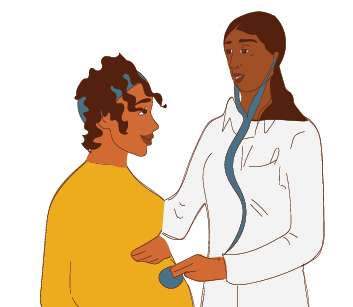Due to the fact that in countries like ours, issues like these are strictly taboo and that most don’t discuss the issue openly, we have been left to wonder about such parts of our bodies.
Sure, we learned about them in sixth or seventh grade as they were part of the curriculum, but it was an unspoken rule that asking these sorts of questions as well as being curious about the subject made you ‘’balege’’. So, most of us learned at a young age to suppress our curiosity about such topics. Cultures that frown upon open discussion of such topics can affect the lives of young children in a lot of ways. Boys can go through one of the most challenging periods of their lives in confusion without getting the help they need, and girls for whom discussion of such topics is of the utmost importance, go through difficult challenges alone and often in a lot of confusion.
Below we have listed the different anatomical parts of both the female and male reproductive systems to give readers more insight on what our body parts actually are.
The male reproductive anatomy, the external at least, because of the fact that it’s easily visible, can be understood without much difficulty. This isn’t the case for female reproductive anatomy, however. Because of this fact, most females find it difficult to make sense of the things that take place inside their own bodies, and often they have almost no one to talk to about their bodies or the changes their bodies go through.


The female reproductive anatomy can be divided into two parts, the external and the internal reproductive areas. The external anatomy contains the following major parts:
- The external set of lips that are immediately visible are called the labia majora and the labia minora.
- The Bartholin glands that supply the vagina with the secretions it needs to prevent friction.
- There are the two openings: the urethra through which the body gets rid of urine. and the opening of the vagina that leads to the uterus.
- There is also the clitoris, which is the main pleasure center of the vulva, filled with nerve endings.
Through the vagina we find the internal parts of the female reproductive anatomy:
- Immediately after the vagina, we find the cervix, which serves as a gate to the uterus.
- The uterus is one of the most amazing organs in the female body, its where the baby grows.
- Along each side of the uterus, fanned out as wings we find the two fallopian tubes which transport the eggs from the ovaries to the uterus.
- There are the ovaries which serve as a store and maturation place for the eggs a woman has. The ovary sends out an egg each month to the uterus through the fallopian tubes.

When we come to the male reproductive anatomy, we also have different parts that come together to make their reproductive system. Beginning with the most famous, PENIS!
The penis is made of several parts:
- Glans (head) of the penis: In uncircumcised men, the glans is covered with pink, moist tissue called mucosa. Covering the glans is the foreskin (prepuce). In circumcised men, the foreskin is surgically removed and the mucosa on the glans transforms into dry skin.
- Shaft – The shaft of your penis extends from the tip to where it connects to your lower belly. It looks like a tube. Your urethra is inside the shaft.
- Foreskin – The foreskin is a patch of skin that covers and protects the head (AKA glans). When your penis gets hard, the foreskin pulls back and the tip is exposed. Sometimes foreskin is circumcised (when a doctor surgically removes your foreskin) soon after birth, so not everyone has it.
- Scrotum- The scrotum (AKA ball sack) is the sac of skin that hangs below your penis. Your scrotum holds your testicles and keeps them at the right temperature. If it’s too cold, your scrotum pulls your testicles closer to your body. If it’s too warm, your testicles hang away from your body.
- The testicles- which are found wrapped by the scrotum, serve to produce the sperm and main male hormone known as the testosterone. On top of the testes you will find the epididymis which basically looks like a lining that is found on top of the testes and serves to mature and store the sperm.
From the epididymis, the sperm is then transported through the vas deferens to the urethra, one opening, where in males, both the urine and the sperm get discharged.
Side note, you probably have heard of vasectomies before, a vasectomy is a procedure done on a man that would make him sterile, and the procedure involves cutting out the vas deferens which is where the procedure got its name.
These are the basics regarding the male and female anatomy of the reproductive system. For more information on questions, please feel free to leave comments or questions on our website or other social media platforms.

